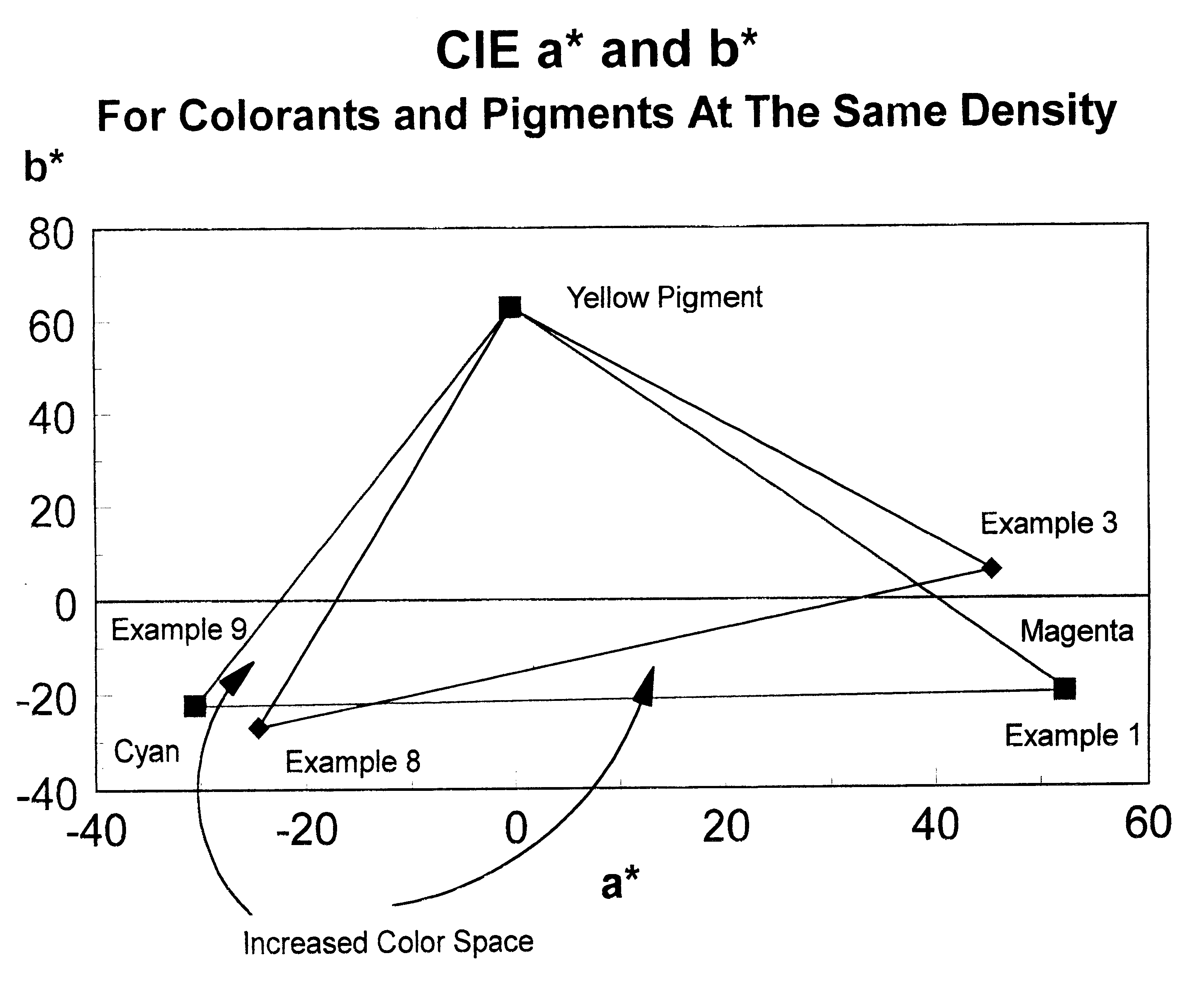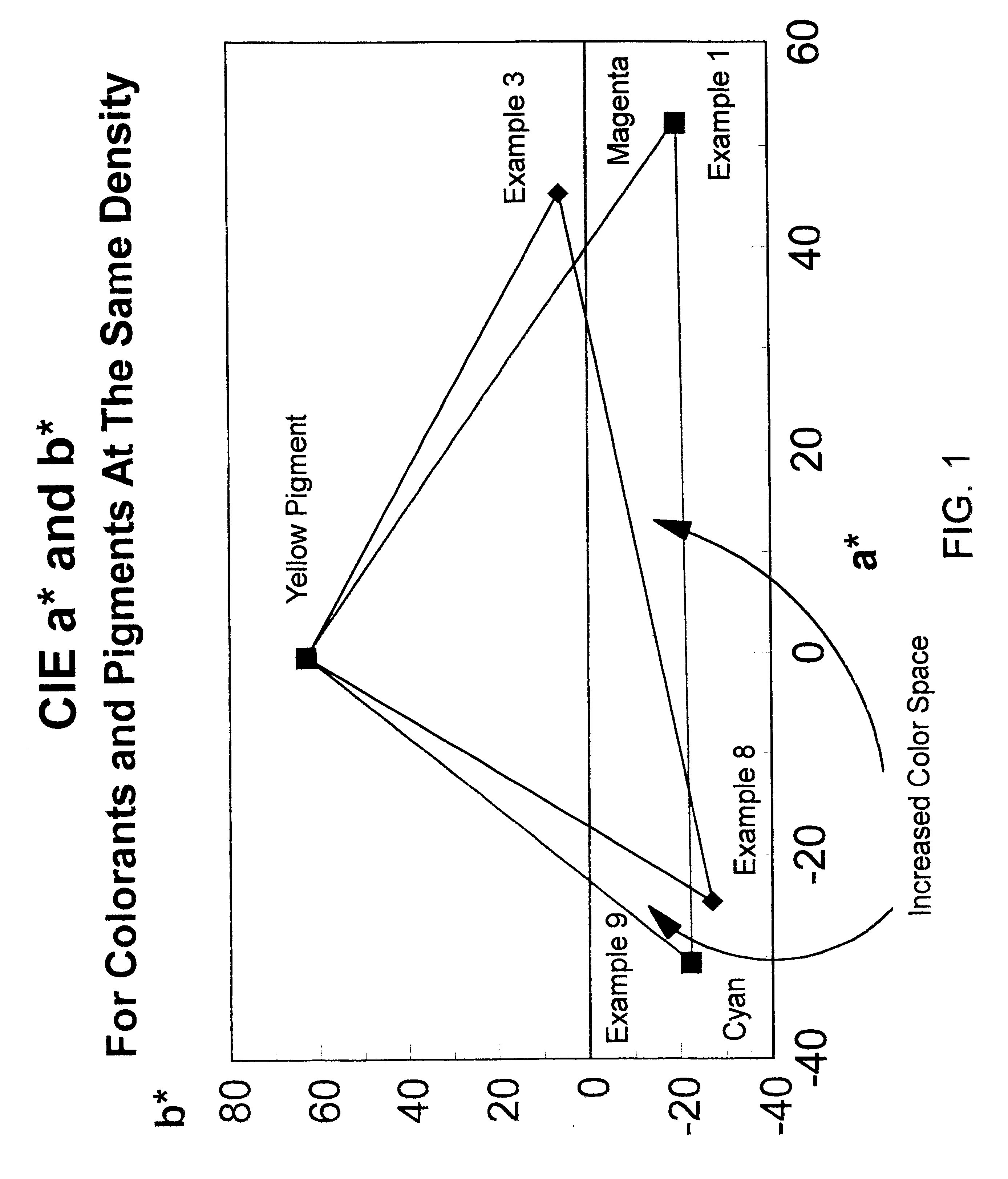Inks exhibiting expanded color-space characteristics for water-based printing
a technology of water-based printing and color space characteristics, which is applied in the direction of inks, porphines/azaporphines, organic dyes, etc., can solve the problem of lack of corresponding coloring properties available to permit full benefit of water-based inks, the limited color space available for such traditionally utilized cyan and magenta flexographic inks, and the difficulty of achieving low viscosity requirements
- Summary
- Abstract
- Description
- Claims
- Application Information
AI Technical Summary
Benefits of technology
Problems solved by technology
Method used
Image
Examples
example 1
Inventive Magenta Dye
An ink composition was produced through the admixture of about 20.8 parts of water with a colorant of about 4.1 parts of a rhodamine B dye (available from Aldrich dye content of about 80%) reacted with about 0.9 parts of dimethyl ethanolamine (DMEA). The resultant slurry was mixed until the dye dissolved within the aqueous solution giving a dark red clear liquid with a pH of about 8.45.
To about 4.9 parts of this resultant clear red liquid, 5.3 parts of Joncryl.RTM.60 acrylic solution resin, 2.4 parts of water, and 1.5 parts of DMEA in order to produce a liquid exhibiting a viscosity of 22 seconds as measured with a #2 shell cup at a pH of about 9.5. The red ink was then drawn down on a newspaper substrate with a hand proofer to give a 0.98 density (print plus the paper). The .lambda..sub.max of the inventive colorant was also measured to be about 534 nm.
example 2
Inventive Magenta Polymeric Colorant
An ink composition was produced through the admixture of about 37.8 parts of water with 48.7 parts of a polymeric colorant (LiquiTone.RTM.Magenta 418 available from Milliken & Company), 12.2 parts of Joncryl.RTM.130 acrylic emulsion, and 1.3 parts of (DMEA) in order to produce a liquid exhibiting a viscosity of 22 seconds as measured with a #2 shell cup at a pH of about 9.5. The resultant polymeric colorant ink was then drawn down on a newspaper substrate with a hand proofer to give a 1.0 density (print plus paper).
example 3
Comparative
An ink composition was produced through the dispersion of 50.0 parts of Acroverse.RTM. 32R80D lithol rubine pigment (available from Penn Color), 15.5 parts of water, and 34.5 Joncryl.RTM. 60 acrylic emulsion in order to produce a liquid exhibiting a viscosity of 22 seconds as measured with a #2 shell cup at a pH of about 9.5. The resultant red pigment ink was drawn down on newspaper with a hand proofer to give a density of 1.0 (print plus paper).
PUM
| Property | Measurement | Unit |
|---|---|---|
| density | aaaaa | aaaaa |
| water solubility | aaaaa | aaaaa |
| compatibility | aaaaa | aaaaa |
Abstract
Description
Claims
Application Information
 Login to View More
Login to View More - R&D
- Intellectual Property
- Life Sciences
- Materials
- Tech Scout
- Unparalleled Data Quality
- Higher Quality Content
- 60% Fewer Hallucinations
Browse by: Latest US Patents, China's latest patents, Technical Efficacy Thesaurus, Application Domain, Technology Topic, Popular Technical Reports.
© 2025 PatSnap. All rights reserved.Legal|Privacy policy|Modern Slavery Act Transparency Statement|Sitemap|About US| Contact US: help@patsnap.com


